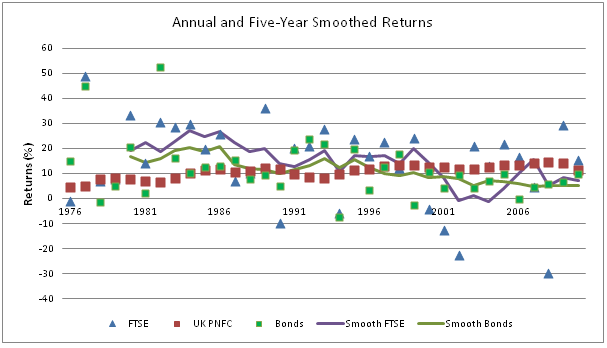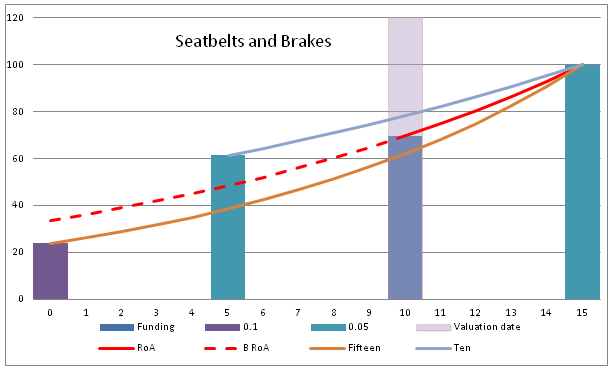Noise and Signal
Tuesday, 12 March 2013By Con Keating
Houston, we have a problem. Not quite what Swigert or Lovell said, but it is certainly true of scheme valuations. While examining 22 schemes in preparation for the EFFAS response to the DWP Call for Evidence on smoothing, I calculated the average signal to noise ratio of these schemes. It was staggeringly low at just 27%; for one scheme, it was less than 10%.
The concept of the minimum discernible signal is immediately relevant; the signal cannot be separated reliably from the noise until it exceeds the level of the noise, but here it is half the noise level. The inference: these schemes have been managing their affairs on a wing and a prayer - and so have both the Pensions Regulator and the PPF.
These may not be a representative sample of schemes overall, but they ranged from the very large to the small; they had followed a range of investment strategies and degrees of “prudence”; some had closed to new members and some to future accrual. This was a rather diverse sample. In fact, these management operations had amplified the average annual increase in total liabilities over the past five years to 4.2% p.a. from 2.3%; in other words, the signal in the period under analysis was large.
Simple averaging lowers reported volatility and increases the signal to noise ratio. With five year smoothing, it only increases to 29%, but with 25-year smoothing to 46%. This hardly seems worth the effort in the five-year case, but the story does not end there. At an annual frequency, the correlation between equity and debt returns is 0.48 and increases to 0.82 under five-year smoothing. This correlation is actually higher than some schemes are achieving with their complex liability driven investment strategies. It is also notable that the correlation between equity returns and the return on capital of the UK private sector decreases from -0.29 to -0.44. In other words, equity is seen to have better diversification characteristics, and is better at enhancing member security than previously thought. Finally, when bond yields are smoothed, they relate more closely to the profitability of the UK corporate sector; liability values become more closely aligned with the corporate sector’s ability to pay. Figure 1 shows the time series of returns from equity, bonds and the UK private non-financial sector, together with five-year smoothed equities and bonds. This also makes evident that, for more than a decade, the returns from financial markets have been lower than the profits of the UK corporate sector – funding has been inefficient over this period.

There is an important caveat this; the use of smoothing does not contain any new information as to the value of assets or liabilities – but it does make proportional trends in funding status more evident. As a risk management tool, it is superior to the status quo. However, the real merit of smoothing lies in its value as signal of the intention of government to resolve the issue of valuation correctly.
The Regulator has asserted that there is sufficient flexibility in current regulation and that it already considers affordability to the employer sponsor.
The claim to adequate existing flexibility rests, in very large part, on the use of the expected return on assets as a discount rate. This fails to recognise that the use of a common discount rate for assets and liabilities is a necessary but not sufficient condition for accurate scheme evaluation. One problem is that this will not result in accurate sponsor liability exposure values, no matter whether the scheme is in deficit or surplus. Under this approach, the volatility of the asset portfolio becomes all-important and for our illustrative schemes, this averages 14.1% of scheme value. Any consistent derivation of the expected return on assets will retain the volatility of those assets. The signal to noise ratio would be just 23%, while under current regulation it is 27.0%. In other words, using the expected return on assets in a consistent manner actually results in outcomes that are less informative than under current approaches. This could represent a serious risk for the PPF as it admits the possibility of significant misstatements of liabilities in times of sponsor distress and manipulation of reported scheme funding status in evasion of levy obligations.
The Pensions Regulator’s claim of flexibility in agreement of deficit repair schedules conflicts with numerous reports by actuaries, other advisors and trustees of considerable difficulty in agreeing these. Here, flexibility conflicts with its responsibilities to the PPF. If the Regulator is already using this flexibility, it is clear that this must be inadequate from the perspective of sponsors for the Call for Evidence to have come into existence. Moreover, if the Regulator is using this flexibility, they really should be accountable for its consequences, which they would be if it were an explicit objective.
The fact that this Call came about gives the lie to the often-repeated assertion that sponsor employers no longer wish to provide DB pensions. It is evident that their concern is with provision under current practices and regulations.
We should be concerned that both the Regulator and the PPF believe that “funding trumps covenant”. In the past, we have likened this to believing that seatbelts trump brakes. This view is in direct conflict with the Regulator’s sponsor assertions. This funding view gives rise to the belief that two schemes with identical assets and liabilities have an equal funding ratio, which is incorrect. The liabilities that should be recognised by a sponsor depend upon the terms under which they were originated. This subject is explored in depth in a recent paper titled "Keep Your Lid On: A Financial Analyst’s View of the Cost and Valuation of DB Pension Provision", which shows how schemes may be accurately valued without recourse to market rates or prices.
This point is illustrated (as figure 2) using zero coupon bonds issued by two companies. One was originally a fifteen-year issue which offered a 10% rate of return to maturity – the valuation date is five years prior to maturity. The other was a ten-year issue that originally offered 5% as a yield to maturity.
The 5% bond has a liability value of 78.35% at the valuation date, five years prior to maturity, while the 105 bond has a value of 62.09%. A creditor may claim these amounts if insolvency were to arise at valuation date. This is the acceleration position for a coupon-bearing bond; at insolvency, the creditor’s claim is for repayment of principal plus accrued interest under the original terms. This is sound mitigation of the inherent moral hazard problem.
Suppose that these bonds have assets of 69.66 as security, with an expected return of 7.5% to the five-year maturity, then rather than being both identically (and fully) funded, we see that the 5% issue is underfunded and the 10% issue overfunded. Back-projection of this level of funding shows that the funding view is not time consistent as it implies that the 5% was over-funded at inception and that the 10% issue was underfunded.
This is a form of market price valuation issue. The market price may be the value to the marginal investor, but that value is not the company’s obligation, nor is it the value that a creditor may claim in insolvency. Market consistency is neither fair value consistent nor time consistent.

To our knowledge, neither the PPF nor the Regulator considers this aspect of the sponsor obligation, which in turn means that they are basing their judgements on incorrect estimates of scheme liabilities. This funding trumps covenant view is all pervasive; the Regulator supports it, and the PPF actively promotes it through levy amount determinations. This goes well beyond concern with the quantum of funding and extends to the composition of the fund.
It is also notable that the Regulator’s actions in pursuing insolvency recoveries in the courts have also contributed to the unwillingness of banks and others to lend to companies. Numerous public statements were made that the judgements obtained would result in higher lending margins and lower availability of bank credit. A cost-benefit analysis of this legal pursuit, and its consistency with consideration of the interests of sponsor employers would be most interesting.
The special contributions, required by the Regulator over its lifetime, could have reduced the dependence of the UK private sector on their banks by more than 50%, lowering their likelihood of insolvency. Funding is, at best, an incomplete solution to the problem of sponsor insolvency, and in recent times ineffectual; lowering the likelihood of insolvency is superior in many regards.
In pursuing these claims and contribution demands, it was correctly pursuing its objective of protecting the PPF, but at potential costs to sponsors that are substantial, and probably went without formal analysis or consideration. These are powerful arguments for an additional objective for the Pensions Regulator, and for smoothing as a first step towards correct valuation practices.
Note: the two EFFAS responses to the DWP Call for Evidence and the paper, “Keep your lid on!” are freely available from www.longfinance.net. These issues will also be discussed at a Financial Services Knowledge Transfer Network/University of Warwick conference taking place at the Royal Statistical Society in London on March 21/22.